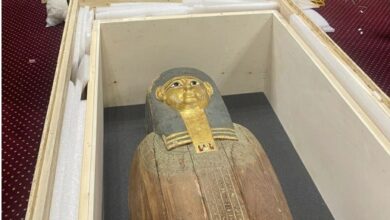Science is playing an increasing role in supporting fields in the humanities, like Egyptology. As evidence, interpretations of the historical chronology of ancient Egypt–which are generally based on historical documents and archeological findings–have been verified by radiocarbon dating, which uses the naturally occurring radioisotope carbon-14 to determine the age of organic remains from archeological sites.
In a recent study published in Science Magazine on 18 June 2010, an international team of nine research professors (French, Austrian and Israeli) led by Bronk Ramsey, director of Oxford Radiocarbon Accelerator Unit at the Oxford University, have apparently determined more accurate dates for the ruling dynasties of Ancient Egypt by analyzing 211 samples.
The researchers tested seeds, baskets, and textiles, collected from tombs belonging to various museum collections across Europe and America, that had been previously dated.
The three-year study produced interesting results, some of which support the conclusions reached by conventional dating methods, while others don’t.
The dates of the Old Kingdom and Middle Kingdoms roughly correspond to the conventional historical chronology, with minor differences.
However, the results obtained by Ramsey’s team suggested a different chronology for the New Kingdom. With an average calendrical precision of 24 years, the new carbon dating results indicate the kingdom came into existence a decade before the convetional date of 1550 BCE.
The new evidence also suggests the Minoan Santorin eruption, which is a crucial stratigraphic time marker in the eastern Mediterranean region during the second millennium BCE, happened between 1626-600 BCE, and not around 1500 BCE as it is widely thought. This is considered crucial by researchers to better understand relations between Egypt and the other Mediterranean societies.
“For the first time, radiocarbon dating has become precise enough to constrain the history of ancient Egypt to very specific dates,” said Ramsey in AFP report.
However, Zahi Hawass, Egyptian archeologist and secretary-general of the Egyptian Supreme Council for Antiquities, strongly disagrees with the use of carbon dating in archeology.
“Carbon-14 dating has a margin of error of 100 years. In order to date Egyptian dynasties, we need to have specific dates; you cannot use carbon dating,” Hawass explained to Al-Masry Al-Youm. “This technique shouldn’t be used at all in making changes to the chronology of the ancient Egypt, not even as a helpful addition.”
By contrast, Salima Ikram, professor of Egyptology at AUC, showed interest in the results.
“They fit well with the archeological evidence that we already have,” she said. “Of course, ten years from now, there might be an improvement in carbon-14 dating, and the current crop of dates will have to be revised. Hard science is helpful, but should always be contextualized and tested against other data.”
While the results of Ramsey’s research may present a compelling reason to revise records for the two millennia when Egypt dominated the Mediterranean world, Hawass remains categorical in his rejection of the technique: “Not even in five thousand years could carbon dating help archeology. We can use other kinds of methods like geoarcheology, which is very important, or DNA, or laser scanning, but carbon dating is useless. This science will never develop. In archeology, we consider carbon dating results imaginary.”




